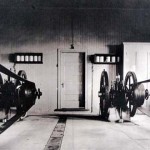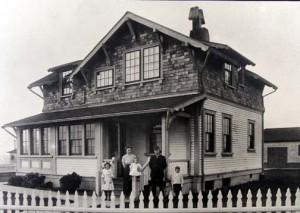Light Station History
The Buildings
Although Point Cabrillo was surveyed by the U. S. Lighthouse Service in 1873, construction of the Light Station didn’t begin until 1908. The demand for lumber meant that maritime commerce on the north coast was at an all time high and a lighthouse was critical to the safety of the ships and their valuable cargo. The lens was illuminated for the first time on June 10,1909, under head keeper Wilhelm Baumgartner.
 Baumgartner invited the neighbors and residents of Pine Grove to attend the midnight ceremony.
Baumgartner invited the neighbors and residents of Pine Grove to attend the midnight ceremony.
Built and managed by the US. Lighthouse Service under the Department of Commerce the original Point Cabrillo Light Station consisted of most of the buildings still standing today: the three keepers’ residences, the storage buildings (two of which are rental cottages, the third houses bathrooms), the Blacksmith & Carpentry Shop (now home to the Marine Science Exhibit), and the Oil House. Two buildings that were moved or added after original construction include one water tower and companion pump house which are located behind the First Assistant Lightkeeper’s Home Museum. Three original structures have not yet been re-constructed: one water tower, the barn and one utility building. The barn, which was located to the south of the residences at the end of a side road, was used as a US Air Force radio monitor’s training facility after WW II. It was burned by the Volunteer Fire Dept. as an exercise in the late 1980s.
Fog Signal
 The Lighthouse and Fog Signal Building share a common wall and appear to be one structure. The Fog Signal Building housed a pair of engines and compressors that created a siren using compressed air.
The Lighthouse and Fog Signal Building share a common wall and appear to be one structure. The Fog Signal Building housed a pair of engines and compressors that created a siren using compressed air.
Two 18-horsepower gas/kerosene engines and compressors powered the fog signal. These occupied the entire ground floor of the building. The fog horn signature was 2 seconds on, 2 seconds off, 2 seconds on, and 24 seconds off.
The Lens
 One enters the Lighthouse at the base of the Light Tower. The Lantern Room at the top of the Tower houses a 3rd order British-built Fresnel lens by Chance Bros. with a range of 13-15 miles. The lens was originally powered by a kerosene oil lamp. There are only two other British-built lighthouse lenses in operation in the U.S. today: a 1st order lens at Heceta Head Lighthouse in Oregon and a 2nd order rear range light at Ambrose Channel, Staten Island, New York.
One enters the Lighthouse at the base of the Light Tower. The Lantern Room at the top of the Tower houses a 3rd order British-built Fresnel lens by Chance Bros. with a range of 13-15 miles. The lens was originally powered by a kerosene oil lamp. There are only two other British-built lighthouse lenses in operation in the U.S. today: a 1st order lens at Heceta Head Lighthouse in Oregon and a 2nd order rear range light at Ambrose Channel, Staten Island, New York.
Originally the lens rotated by means of a clockworks mechanism with a descending weight. A chain with a 65-80 pound weight on the end of it passed through the floor of each level of the Light Tower. The lightkeeper would crank up the chain onto a drum every 2 hours. At some point, a portion of the floor and concrete foundation on the ground floor was removed to add an additional 4-5 feet to the chain, gaining (perhaps) an additional ten minutes between windings. The kerosene fueled wicks were replaced with a bulb hung into the lens when electricity was introduced to the Light Station in 1935. In 1937 the clockworks was replaced with an electric motor.
The four-sided bullseye lens rotates at a fixed speed to produce a flash at ten second intervals. The rotation pattern of a lighthouse is printed on the nautical chart; it is the lighthouse signature and must not vary.
The Keepers
 A head keeper and two assistants rotated shifts to keep the light burning and the compressors powered. They were responsible for keeping the lens and station machinery in working order and for all maintenance of the Station buildings and grounds. The lighthouse service gave them each a house for their family and a yearly salary of $450-$600. They were allocated supplies but supplemented these by planting gardens and caring for livestock.
A head keeper and two assistants rotated shifts to keep the light burning and the compressors powered. They were responsible for keeping the lens and station machinery in working order and for all maintenance of the Station buildings and grounds. The lighthouse service gave them each a house for their family and a yearly salary of $450-$600. They were allocated supplies but supplemented these by planting gardens and caring for livestock.
The U. S. Lighthouse Service was officially absorbed into the Coast Guard in 1939. Bill Owens, who also served at the Point Arena Lighthouse, was the last civilian lighthouse keeper at Point Cabrillo. He retired in 1963. Coast Guard officers and their families continued to live in the keepers’ houses until the Conservancy took possession in 1992.
Read about the more recent history of the light station – the disengagement and subsequent restoration of the original lens.
